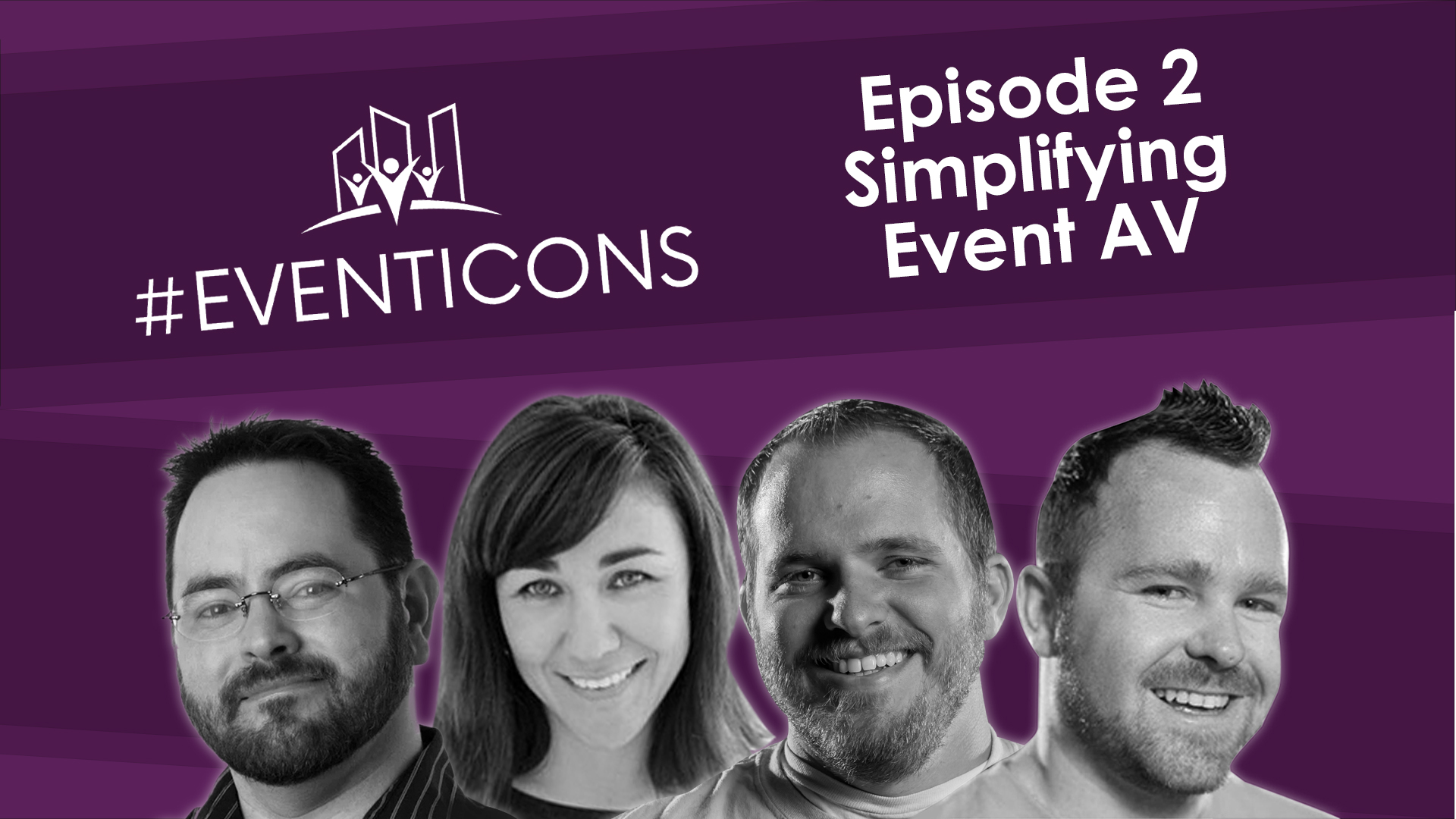The second episode of #EventIcons is here! Today, Will welcomes three AV gurus, Brandt Krueger, Andrew Latimer and Midori Connolly, in hopes of simplifying event AV. In an hour-long conversation, they cover all kinds of topics, ranging from the future of AV to their personal tips for event planners.
Editor’s Note: This post was updated on April 26th, 2021 for clarity purposes.

Theater & Event AV Go Hand In Hand
Will’s first question is directed to Brandt and Andrew as they both have theater background. “Did you end up using your knowledge from theater in order to create events and awesome experiences?
Andrew answers first. “It definitely played into giving a foundation to build upon. There was a lot of very practical things, such as color theory, lighting design, set design, basic carpentry, that really have just come in handy at various times as I’ve matured in the industry. It gave me the platform to have that breadth, and then add the depth to it.”
Brandt thinks that events – especially corporate meetings – have a lot in common with theater. “We talk about things as being spectacles, as being experiences. In a theater, you spend all this time leading up to something that lasts for a week. In events, however, you spend all this time leading up to it and you only have one shot at it. If anything, it’s a more concentrated version of what you learn in doing theater.”
Simplifying Event AV
“How do you guys feel like event technology is affecting the event space? Is it benefiting it in a positive way? Are there some ways where technology is too much?”, asks Will.
Brandt firmly believes that people shouldn’t use new technology just for the sake of it being new. “I don’t think it’s a matter of it being too much, but using things properly. The temptation sometimes is to go with whatever’s cool, flashy, and new rather than working your way into technology that’s going to accomplish what you want to accomplish.”
“Rental houses traditionally have made money off of basic projectors and microphones. Now, we have so many different types of interactive and holographic technologies,” says Midori. “In our industry, some companies are starting to see that they should advise their clients and find ways to help them buy this cheap equipment that they can use over and over. Become a consultant and advisor on some of the more mundane technologies, which they can buy themselves. Then, let’s get creative and help them become better experience creators. The more progressive AV companies out there are creating these relationships and having effective conversations and not just focusing on where’s the highest profit margin.”
Are we looking at high profit or are we looking at high rate of return? Because if we put something out that’s high profit for us and it sinks their budget, then they probably won’t come to us next year,” adds Andrew. “They might not even be able to have the event next year. Let’s do something that enables their financial success. Hopefully it does the same for us as a company. But we want the event to come back over and over, so that it creates a longstanding relationship.”
Simplifying Event AV With Great Relationships
Will’s next question for the event icons is the following: “What sort of things can someone do to strengthen their relationship with an AV provider?”
Andrew believes that clients should get involved as early as possible. “The more time we have to build that relationship, the more details we can focus on, the more we can help your event.”
Midori makes a great analogy. “You want to look at your provider as a healthcare provider. You trust them, like you trust your doctor and you’re not afraid to disclose your budget. Don’t be afraid of sharing all the information that you can. It will bring effective results.” And you will get your AV quotes faster!
What Does The Future Hold?
“What is one piece of new technology in AV that you’ve seen that you think is going to change the industry?”
Brandt thinks that projection is one of the most underused things that event tech profs do. “We can be doing so much more with display and projection technology, just thinking creatively. Sometimes we get up in projection mapping: it needs to be a casino, the Hoover dam or something along those lines. We can do so much more on the small scale. That’s only going to get cooler as time goes on because the display technology is getting better and better.”
Midori thinks that the future is all about better audience engagement. She mentions Catchbox as an example. “It gives people a chance to have a voice. How do we break down the barrier between the stage and the person sitting in the audience? Audio is one way to do that. Even these interactive event apps that people can vote on are amazing to me. The audience member can feel like they have an impact. The event has sort of shrank and become more personal, too.”
Andrew’s favorite technology is live streaming for events. “It is somewhat native to their platform, the ability to integrate people’s phone camera by the app, into your live production.”
Simplifying Event AV: Why Is AV So Expensive?
Up next, Will tells his guests that he noticed that people wonder why AV is so expensive. “Why do you think that people say that?”
Midori ‘s straight-forward answer is that it’s because AV is expensive and explains why it is so. “You do a breakdown of the cost to buy a professional grade projector. You’re looking sometimes at tens of thousands of dollars. But it’s not just the purchase of that equipment. It’s the maintenance and upgrading. We’re talking about equipment that is built to last. And if you do a breakdown, you consider theft, insurance, you build in a profit margin – because it’s a business.”
Brandt rephrases Will’s question. “How do I know if it’s costing too much?” It varies so wildly: city to city, country to country, even venue to venue within the same city.” Here’s his answer. “Just educating the consumers as far as what this stuff is and what it does and whether or not you need it is what’s going to go a long way towards making people feel better about the choices that they make, or the conversation that they’re having with their AV companies.”
One of Midori’s clients was working on a gala event and she came to her, asking whether she could look at a certain estimate since she didn’t know how. Midori advised her to compare the base rental cost. “We’re going to go side by side and you’re going to compare the line item costs.” Andrew agrees with her approach. “The apples to apples comparison is always something that I encourage anyone planning an event to do before any of your bids. If you have the option, if you have the flexibility to use different vendors, take that extra time, get the second opinion.”
What To Look For In An AV Quote
“Is there anything that you guys look out for when you’re reading an AV quote?”
“Being able to kind of look line by line is a really great place to start. Also, ask your project manager or sales representative to actually spell out what’s on that estimate. Don’t be afraid to push back! Say that you would like a detailed explanation of what this system is comprised of,” says Midori.
Brandt warns that while line by line approach is great, it’s important to aim to be somewhere in the middle. “Lump sum is too little information, but then unfortunately, sometimes there’s too much information. It drives me nuts when you’re looking at a bid and it’s basically the picklist for the warehouse.”
Andrew shares an operational tip. “Any AV company that’s using an inventory system has the ability to add a note line.” That way, they can clear up any misunderstandings right away. “CAD designs are another accessible way to get a visual understanding of what you’re looking at,” he adds.
Midori sums it up perfectly. “The more information we can provide to our buyer, the more empowered they will be. And I think that that builds the healthiest relationship.”
Conclusive Tips & Tricks
Before Midori, Andrew, and Brandt say their goodbyes, Will shares his go-to tip for making the planning process of in-person events much easier and asks his guests to do the same.
Midori urges event planners to do comparison shopping, as they would for a new TV. “When you’re choosing your venue, make sure that you carefully read through your contracts for any production stipulations. Make sure that you have the flexibility to either use the in-house or at least be able to go out and receive multiple bids on your projects.”
“One thing that people don’t often realize is you can ask for references for the in-house too,” adds Brandt. “If I’m thinking about coming to your venue, I would like to speak to someone who’s been at your venue in the last three to four months. You can ask an AV company for references and to speak to someone who’s used it recently.”












